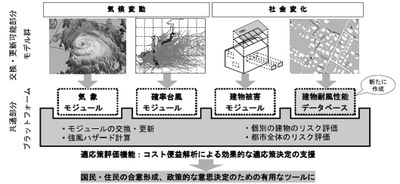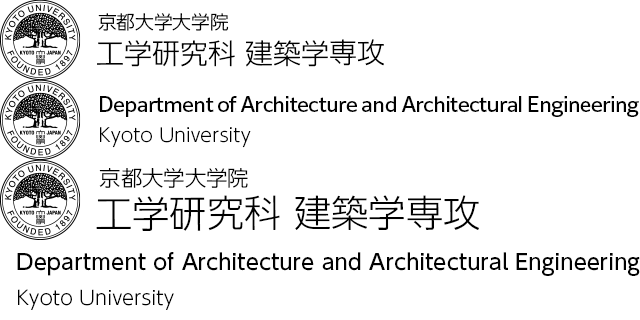Architectural Wind Engineering
The goal of our research is to reduce wind-related disasters such as due to typhoons and tornadoes. We approach this goal by both wind engineering perspective and risk management perspective: i.e. (1) identifying characteristics of wind field around structures under various wind conditions, dynamic responses of structures to wind actions and their interactions, and physical processes that lead structures to their damages; (2) developing methodologies for consequence assessment of wind-related damages and decision optimization for efficient risk reduction measures. In the former, we conduct observations, experiments and numerical simulations; in the latter, field survey and methodological research. Besides these, we also conduct research for exploiting wind as natural resource for the benefit of society. Through these researches we are proposing how to better shape buildings and cities in relation to the wind environment.
Academic Staff
Kazuyoshi NISHIJIMA
 Professor (Disaster Prevention Research Institute)
Professor (Disaster Prevention Research Institute)
Research Topics
- Wind vulnerability modelling for structures
- Real-time decision optimization of risk reduction actions in approaching typhoons
- Adaptation of structures to changing wind environment by climate change
- Improvement of wind-resistant performance of non-engineered structures
Contacts
Uji Campus, DPRI, 5F, E520D
TEL: +81-774-38-4165
E-mail: nishijima.kazuyoshi.5x![]() kyoto-u.ac.jp
kyoto-u.ac.jp
Yuki TAKADATE
Associate Professor (Disaster Prevention Research Institute)
Research Topics
- Evaluation of wind loading on buildings using wind tunnel testing and CFD simulations
- Aerodynamic behavior and unsteady aerodynamic forces acting on buildings
- Wind-resistant performance of roofing materials based on full-scale experiments
- Field investigation and analysis of wind disaster damage mechanisms
Contacts
Uji Campus, DPRI, 5F, E527D
TEL: +81-774-38-4169 / FAX: +81-774-38-4170
E-mail: takadate.yuki.5f![]() kyoto-u.ac.jp
kyoto-u.ac.jp
Research Topics
Identification and modeling of physical mechanisms of structural failures by strong/gust wind
Strong wind by typhoons and gust wind by tornadoes and downbursts often cause severe damages to buildings. For identifying effective damage reduction measures the first step is to understand the causes of those damages. These causes include, for example, roof tile failures, window damages due to flying debris impacts, material fatigue failures due to vibration, structural element failures. Further, several of those causes have cascading nature.
This research first aims at identifying these failure mechanisms by means of wind tunnel experiments, material strength tests, impact failure testing as well as numerical simulation methods. On these basis, models are developed up to the necessary and sufficient extent for wind-resistant performance of buildings. Finally, with the developed model efficient damage reduction measures are examined and proposed.

Figure 1 Numerical simulation (left), glass impact experiment (middle), material test (right)
Development of wind risk assessment platform accommodating societal and climate changes
Wind environment surrounding buildings is changing. This change is, among others, due to changes of building profiles such as building density and building height and changes in occurrence frequency and intensity of typhoons and tornadoes triggered by the global climate change.
The objective of this research is to develop a generic platform for the assessment of wind risks that accommodate not only the abovementioned changes but also changes in spatial distribution of building stocks and population as well as industry etc. over time. By replacing some of the modules it is then possible to assess the changes in wind risk in the future.

Figure 2 Generic risk assessment platform
Development of comfortable wind environment and application of natural energy
We try to develop comfortable wind environment in an urban area. We also develop prediction methods of wind environment in complex terrains such as mountain areas to utilize wind energy. We investigate optimal arrangement of wind-breaking facilities, safe and efficient operation of wind farm or solar power plant.

Figure 3 Wind turbines in wind farm
Field survey of strong wind damages and proposal of improved wind design method for non-engineered structures
Many of buildings such as high rise buildings, large-span buildings, and other buildings in developed countries are to a large extent engineered structures, which are designed and constructed based on engineering knowledge. On the other hand, however, looking at the statistics on the wind-related disasters worldwide, a large fraction of damages are accounted for by non-engineered structures mostly located in less developed countries. Therefore, it is important to mitigate damages of those non-engineered structures to reduce wind-related disasters worldwide.
Based on this observation this research aims at creating engineering knowledge body useful for improving wind-resistant performance of non-engineered structures. The emphasis is put on the cultural and societal continuity of building stocks by appreciating local building characteristics.
The outcomes from the research can be facilitated directly to the improvement of design methods and/or design codes, but also serve as a basis for target-oriented international aid resource allocation.
So far we have conducted surveys in the Republic of the Philippines in the connection of typhoon Yolanda damage survey and other countries in southeast Asia and started developing models.

Figure 4 Non-engineered buildings
